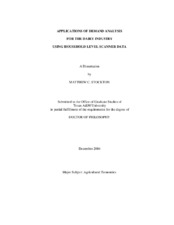| dc.description.abstract | This study illustrates the use of ACNielsen Homescan Panel (HSD) in three
separate demand analyses of dairy products: (1) the effect of using cross-sectional data
in a New Empirical Industrial Organization (NEIO) study of ice cream firm mergers in
San Antonio; (2) the estimation of hedonic price models for fluid milk by quart, halfgallon
and gallon container sizes; (3) the estimation of a demand system including white
milk, flavored milk, carbonated soft drinks, bottled water, and fruit juice by various
container sizes.
In the NEIO study a standard LA/AIDS demand system was used to estimate
elasticities evaluating seven simulated mergers of ice cream manufactures in San
Antonio in 1999. Unlike previously published NEIO work, it is the first to use crosssectional
data to address the issue associated with inventory effects. Using the method
developed by Capps, Church and Love, none of the simulated price effects associated
with the mergers was statistically different from zero at the 5% confidence level.
In 1995 Nerlove proposed a quantity-dependent hedonic model as a viable
alternative to the conventional price-dependent hedonic model as a means to ascertain
consumer willingness to pay for the characteristics of a given good. We revisited
Nerlove’s work validating his model using transactional data indigenous to the HSD.
Hedonic models, both price-dependent and quantity-dependent, were estimated for the
characteristics of fat content, container type, and brand designation for the container
sizes of gallon, half- gallon, and quart. A rigorous explanation of the interpretation
between the estimates derived from the two hedonic models was discussed.
Using the Almost Ideal Demand System (AIDS), a matrix of own-price, crossprice,
and expenditure elasticities was estimated involving various container sizes of
white milk, flavored milk, carbonated soft drinks, bottled water, and fruit juices, using a
cross-section of the 1999 HSD. We described price imputations and the handling of
censored observations to develop the respective elasticities. These elasticities provided
information about intra-product relationships (same product but different sizes), intrasize
relationships (different products same container size), and inter-product
relationships (different products and different sizes). This container size issue is unique
in the extant literature associated with non-alcoholic beverage industry. | en |


